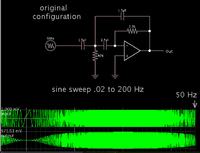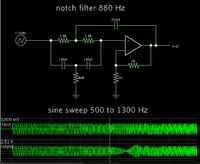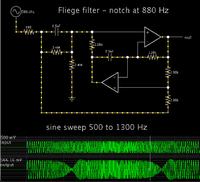zula
Full Member level 2

Hi all,
Iam trying to implement notch filter. I used FilterLab software to design it. Circuit is below.
Iam working on an Acustic Device that produce 880Hz tone. On the other hand i have a microphone circuit to detect ambient voice level.
So i have to eliminate 880Hz at the microphone outputs.
But this circuit doesnt works. Iam observing it with osciloscope there is still 880Hz and its harmonics.
Please give me some advices iam stuck.

Iam trying to implement notch filter. I used FilterLab software to design it. Circuit is below.
Iam working on an Acustic Device that produce 880Hz tone. On the other hand i have a microphone circuit to detect ambient voice level.
So i have to eliminate 880Hz at the microphone outputs.
But this circuit doesnt works. Iam observing it with osciloscope there is still 880Hz and its harmonics.
Please give me some advices iam stuck.





